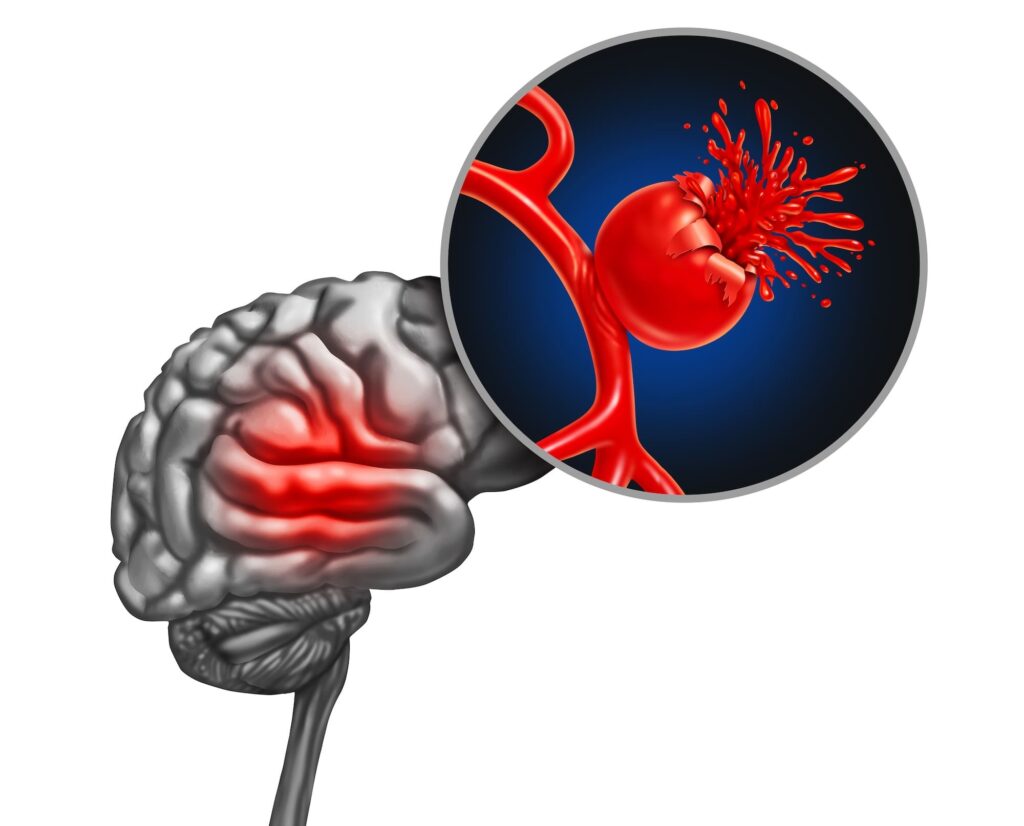A brain aneurysm – also known as a cerebral or intracranial aneurysm – is a bulge in a blood vessel that resembles a blister-like bump in the brain’s arteries. They typically form at arterial branching points, most frequently occurring at the base of the brain, but they can develop anywhere in the brain in various types and sizes.

The cause of brain aneurysm is attributed to the constant pressure of blood flow on a weakened and thin section of the artery wall, leading to its ballooning. In certain instances, a person may be born with a brain aneurysm as a result of a birth defect in the artery wall. Furthermore, inherited genetic factors can increase an individual’s susceptibility to developing a brain aneurysm. In addition, certain medical conditions and lifestyle habits can weaken artery walls over time, further increasing the risk of a brain aneurysm, including high blood pressure, smoking, excessive alcohol intake and substance use.
Not all brain aneurysms carry the risk of rupture. The likelihood of rupture is affected by multiple factors, such as the size, location, and shape of the aneurysm.
Unruptured brain aneurysms, especially when small, often go unnoticed without symptoms and are typically found incidentally during unrelated medical imaging.
When a brain aneurysm ruptures, it can result in bleeding in the brain or surrounding area, which can lead to stroke, brain damage, or even death. Depending on the state of the aneurysm, there are different brain aneurysm symptoms you need to know.
Although a small unruptured aneurysm may be symptomless, a larger unruptured aneurysm can result in the following symptoms as they press on the brain tissue and nerves:
A leaking aneurysm can involve the release of a small amount of blood into the brain, often referred to as a “sentinel bleed.” These leaks can occur days or even weeks before a major rupture. That said, only a minority of individuals have a sentinel headache prior to a rupture.
Nevertheless, when it does happen, a sentinel headache is characterised by a sudden and extremely severe headache that can persist for several days or even up to two weeks, serving as a potential warning sign of an impending aneurysm rupture. Besides a sudden and severe headache, which is the most common symptom of a leaking aneurysm, other potential symptoms include the following:

A key symptom of a ruptured brain aneurysm is the onset of a sudden and intense headache (i.e., thunderclap headache). It is frequently described as the most severe headache an individual has ever experienced with possibly additional symptoms such as:

Between an unruptured, leaking and ruptured aneurysm, the presence of a headache is a shared symptom. While an unruptured or leaking aneurysm may present as persistent headaches lasting days to weeks, a ruptured aneurysm is often characterised by a sudden and severe “thunderclap” headache.
This type of headache is significantly more intense, reaching its peak within a minute and lasting for a minimum of 5 minutes or until medical intervention is sought. It is a distinctive sign of a ruptured brain aneurysm headache that sets it apart from other headaches. A ruptured brain aneurysm is a potentially life-threatening medical emergency, and individuals experiencing such sudden and severe headaches should urgently seek medical advice from a neurosurgeon.
Treatment of brain aneurysm will differ depending if it is ‘unruptured’ or ‘ruptured’. In some cases, small unruptured aneurysms may be monitored without intervention, but regular imaging tests and clinical assessment are recommended. Your Neurosurgeon may determine treatment for an unruptured brain aneurysm based on various factors, including:
Treatment for a ruptured aneurysm, on the other hand, can involve emergency surgery with options such as microvascular clipping, endovascular coiling, or flow diversion stents.
By large, brain aneurysms cannot be entirely prevented. However, there are proactive steps you can take to prevent the thinning of your artery walls and hence reduce your risk of a brain aneurysm including:
It is crucial to understand the early symptoms of a brain aneurysm and promptly seek medical attention from a brain specialist when necessary. If you are experiencing severe headaches or are uncertain about your symptoms, be sure to make an appointment for a thorough evaluation and diagnosis. Consult Dr Sein Lwin, our Senior Consultant Neurosurgeon at Advanced Brain and Spine Surgical Centre.
Contact Us For More Information
Your needs are important to us.
For enquiries, leave a message and our friendly team will get in touch with you.
Monday – Friday: 9:00AM – 5:00PM
Saturday: 9:00AM – 12:30PM
Sunday & Public Holiday: Closed
We provide quality specialised care for neuro and spine conditions.
For enquiries, leave a message and our friendly team will get in touch with you.
Monday – Friday: 9:00AM – 5:00PM
Saturday: 9:00AM – 12:30PM
Sunday & Public Holiday: Closed
We provide quality specialised care for neuro and spine conditions.
For enquiries, leave a message and our friendly team will get in
touch with you.
Monday – Friday: 9AM – 1PM | 2PM – 5PM
Weekends & Public Holidays: CLOSED
© 2023 All Rights Reserved | Advanced Brain & Spine Surgical Centre | Terms & Conditions